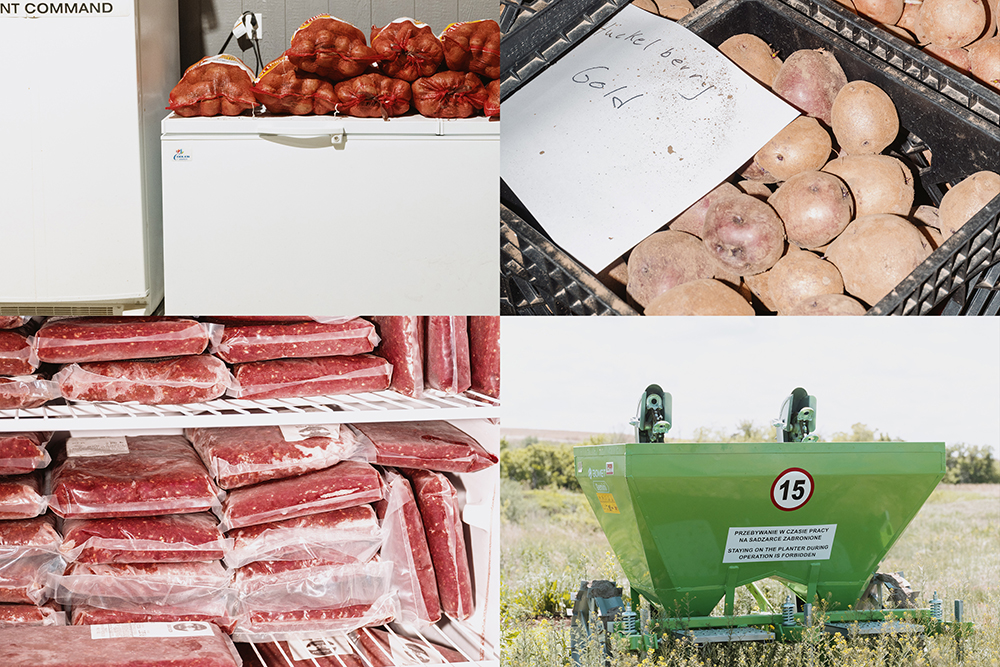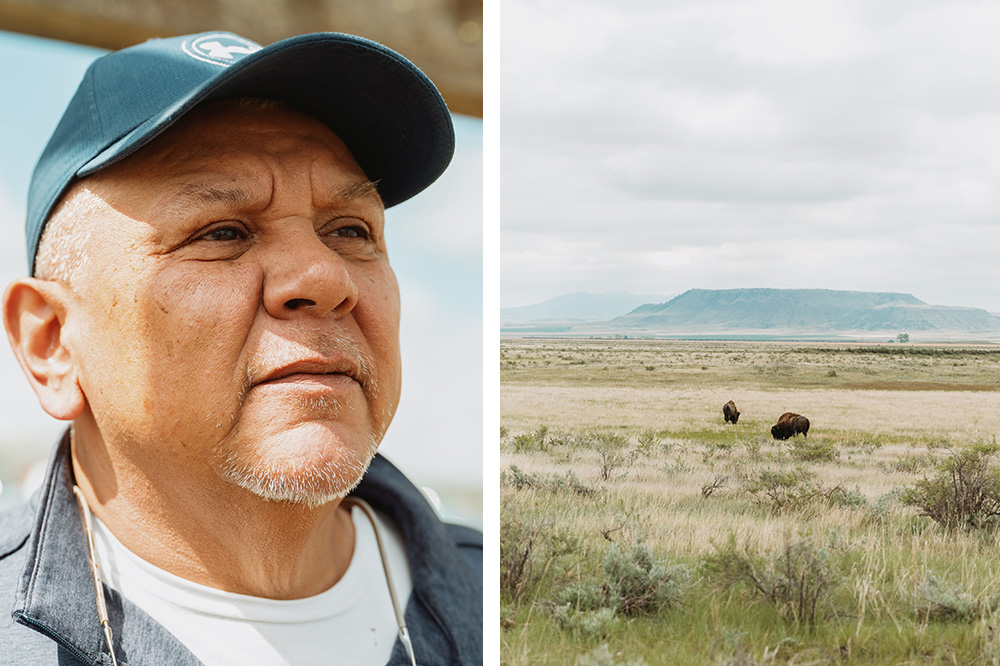
- Details
- By Mary Hudetz, ProPublica
- Food | Agriculture
The USDA has ended a program that dozens of tribal food banks say has helped them provide fresh, locally produced food that is important to their traditions and cultures.
This story was originally published by ProPublica, a Pulitzer Prize-winning investigative newsroom. Sign up for The Big Story newsletter to receive stories like this one in your inbox.
As he has promoted the Trump administration’s “Make America Healthy Again” agenda, Robert F. Kennedy Jr., the U.S. Health and Human Services secretary, has lamented the toll that processed foods have taken on the health of Americans, in particular Native Americans.
Prepackaged foods have “mass poisoned” tribal communities, he said last month when he met with tribal leaders and visited a Native American health clinic in Arizona.
Weeks later, in testimony before the House Appropriations Committee, he said processed foods had resulted in a “genocide” among Native Americans, who disproportionately live in places where there are few or no grocery stores.
“One of my big priorities will be getting good food — high-quality food, traditional foods — onto the reservation because processed foods for American Indians is poison,” Kennedy told the committee. Healthy food is key to combating the high rates of chronic disease in tribal communities, he said.
Yet even as the president tasks Kennedy’s agency and the U.S. Department of Agriculture with improving healthy eating programs, the USDA has terminated the very program that dozens of tribal food banks say has helped them provide fresh, locally produced food that is important to their traditions and cultures.
That program — the USDA’s Local Food Purchase Assistance Cooperative Agreement program — began under President Joe Biden in late 2021 as a response to challenges accessing food that were magnified by the pandemic. Its goal was to boost purchases from local farmers and ranchers, and the funding went to hundreds of food banks across the country, including 90 focused on serving tribes.
In March, the Trump administration decided the program did not align with its priorities. Agriculture Secretary Brooke Rollins defended the cut of a half-billion dollars by calling the program a remnant of the COVID era.
The Department of Health and Human Services did not immediately respond to a request for comment. But in a statement, a USDA spokesperson said the department continues to distribute hundreds of millions of dollars through more than a dozen other nutrition programs that help families meet their nutrition needs. For tribal communities, the spokesperson said, that includes the Food Distribution Program on Indian Reservations for low-income households.
When that program started in the 1970s, it offered processed foods colloquially known as “commodities.” Over the years, the government has added salmon, frozen chicken, produce and other more nutritious options for tribes to include in recipients’ monthly food packages. But few tribes who participate in the Food Distribution Program can purchase food directly from farmers and ranchers, as they were able to do with the now-canceled grant program. Instead, most choose from the USDA’s list of approved and available foods.
Kelli Case, an attorney for the Indigenous Food and Agriculture Initiative at the University of Arkansas, said the program cut by the Trump administration was widely considered an overwhelming success because tribes selected foods based on their nutritional needs and “what people actually want to eat.”
“Having the opportunity to tailor a program makes a huge difference,” she said.
On reservations, the problems addressed by the now-canceled program had been an issue for generations, perpetuated by a string of federal policies, Case added. The pandemic merely “highlighted and exacerbated those issues,” she said.
For instance: In the 1800s, tribes in the West began losing access to traditional food sources — such as berries, salmon and bison — even though treaties promised tribes the right to hunt and fish. Some were removed from their homelands.
The federal government instead provided tribal members with food rations — flour, lard, sugar, coffee and other staples. At the same time, the forcible removal of Native children to boarding schools upended families’ ability to pass along knowledge about the foods they hunted and harvested.
The now-canceled grants helped fill a void, tribes said.
 First image: Jason Belcourt, the Chippewa-Cree Tribe’s sustainability coordinator. Second image: Two of the tribe’s bison bulls at the Buffalo Child Ranch. Credit: Aaron Agosto for ProPublica
First image: Jason Belcourt, the Chippewa-Cree Tribe’s sustainability coordinator. Second image: Two of the tribe’s bison bulls at the Buffalo Child Ranch. Credit: Aaron Agosto for ProPublica
On the Rocky Boy’s Indian Reservation, in an especially remote stretch of Montana, Jason Belcourt said he believed the Chippewa-Cree Tribe was finally getting closer to providing nutritious, local food to every tribal member in need. He expects the tribe’s USDA funding for local food purchases to run out within weeks.
The funding — $400,000 in the past several years — helped the tribe buy beef and produce from local ranchers and farmers. The money supplied roughly 250 households on a reservation where the nearest supermarket is about 20 miles away.
“We wanted to make sure that we didn’t turn away anybody,” Belcourt said. “There are families that go without meals; there are kids that go without meals.”
The tribe also used the money to help harvest bison from the tribe’s herd, which Belcourt said has “done wonders, not only in terms of the food value.” The harvests became community events where younger tribal members learned how their ancestors butchered and used the buffalo. A sense of tribal identity was being restored, he said.
“There’s a lot of cultural sharing. There’s a lot of remembrance from the old timers of what their grandparents told them and how to use the buffalo,” Belcourt said. “And, believe it or not, there’s some healing that’s going on.”
The harvests will continue, Belcourt said. But it’s unclear how he will make up for the loss of $150,000 in funding that the USDA previously awarded the tribe for local food purchases over the next year.
Other tribes are similarly concerned about the future.
The Walker River Paiute in Nevada was the first to receive one of the grants to source local food, including $249,091 in 2022. The community, 115 miles southeast of Reno, used most of the money on locally sourced produce and eggs, according to the USDA. Of the reservation’s 830 residents, both Native American and not, 40% had received food purchased using the grant, according to the tribe.
“I truly believe no one knows the needs of our tribal citizens better than the tribe,” Amber Torres, then the tribe’s chairman, said in a news release.
In late March, a dozen nonprofits that advocate for Native Americans sent a letter to USDA Secretary Rollins, urging her to reinstate the “critical” program as a step toward respecting the sovereign status of tribes. At a recent meeting with USDA officials, tribal leaders again emphasized that they want a say over the food distributed on their reservations.
 First image: A community garden run by the Help Lodge to foster food sovereignty and sustainability on the Rocky Boy's Reservation. Second image: Empty planter shelves in an unused greenhouse at the Help Lodge. Funding cuts have made it difficult to maintain a full staff. Credit:Aaron Agosto for ProPublica
First image: A community garden run by the Help Lodge to foster food sovereignty and sustainability on the Rocky Boy's Reservation. Second image: Empty planter shelves in an unused greenhouse at the Help Lodge. Funding cuts have made it difficult to maintain a full staff. Credit:Aaron Agosto for ProPublica
Tribal communities still have access to the handful of federal food programs. However, last year, the Government Accountability Office, the watchdog arm of Congress, found that some posed barriers to people’s ability to get the food they want or need.
For example, individuals who accept the commodity program’s offerings cannot also receive assistance through the Supplemental Nutrition Assistance Program, commonly known as food stamps. As a result, a household’s needs can go unmet. Sometimes SNAP offers essential cooking ingredients — oil, seasoning or yeast — that the commodity program may not provide, according to the study.
(The local food program was not included in the GAO report.)
On the Fort Belknap Reservation in Montana, the USDA’s local food program had become a reliable fixture, especially since the federal commodity program was paused there, said Tescha Hawley, who is Gros Ventre, or Aaniiih, and a social worker on the reservation. Structural problems had shuttered the building where the commodity program food was warehoused.
A nonprofit Hawley founded, Day Eagle Hope Project, helped her tribe secure $2 million from the USDA to buy fresh local food and process bison meat from its herd. Assiniboine and Gros Ventre tribal members who are capable of gathering wild, nutrient-rich berries exchange them for payment through the grant. She distributed the food first from a shipping container on her property and later a community center.
Over the past few years, the tribe and her nonprofit have distributed thousands of pounds of food. She anticipates the money that remains from past grant funding cycles will run out this winter. For people who can get to a grocery store, up to 45 miles away from some of the reservation’s communities, many will have to make SNAP benefits stretch at a time when food prices are rising.
“So that means even less food for the month,” Hawley said. “People will go without.”
Belcourt said he has begun seeking other grants, and a tribal staffer makes runs to collect food donations in Havre, more than 20 miles away, and Great Falls, about 90 miles away.
“We don't have a Plan B,” Belcourt said of the abruptly canceled grant. “Given the short notice, it’s tough to find a funder in that timeframe.”
Mary Hudetz is an award-winning journalist who covers tribes and federal agencies that serve Native Americans. She lives in New Mexico.